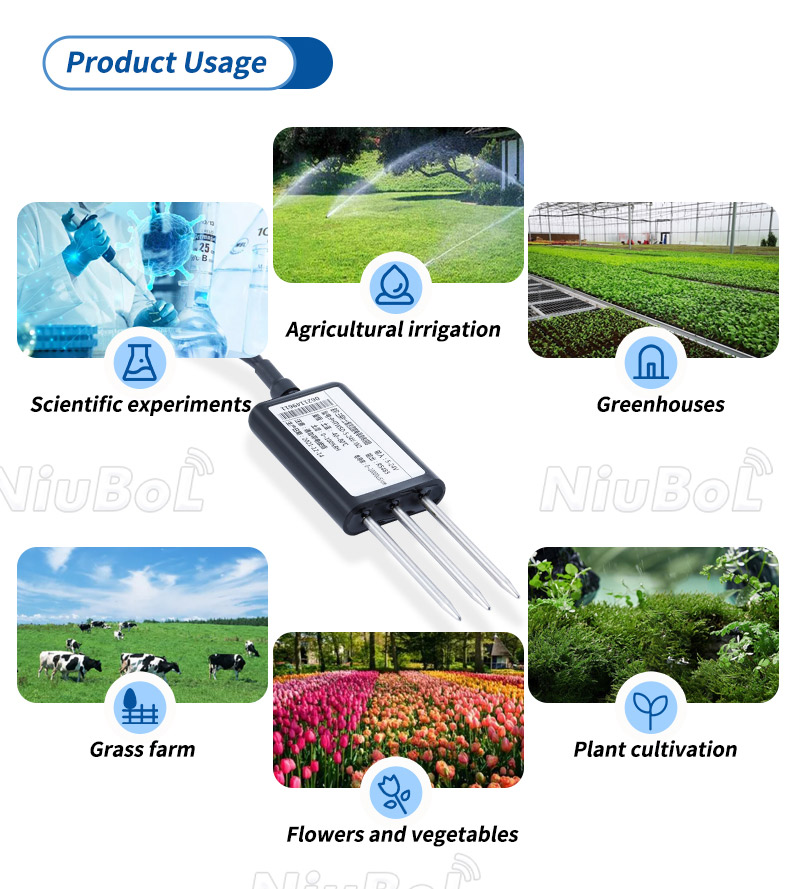

— Blogs —
—Products—
 Consumer hotline +8618073152920
Consumer hotline +8618073152920 WhatsApp:+8615367865107
Address:Room 102, District D, Houhu Industrial Park, Yuelu District, Changsha City, Hunan Province, China
Product knowledge
Time:2022-06-30 21:04:45 Popularity:992
Soil moisture is a critical factor in agricultural productivity, as it directly impacts plant health and growth. The use of soil all-in-one sensors plays an essential role in monitoring soil moisture and related parameters in real-time. These sensors help optimize irrigation management and improve the efficiency of water and fertilizer use. Here's a more detailed explanation of the benefits and features of such a system, as well as its impact on agriculture and the environment:
1. Real-Time Monitoring: The soil moisture sensor continuously monitors the moisture levels, temperature, and conductivity of the soil. This real-time data allows farmers to have immediate access to vital soil conditions, enabling them to make informed decisions.
2. Monitoring Soil Water Potential and Conductivity: In addition to moisture and temperature, these sensors can also monitor soil water potential and conductivity, providing more comprehensive insights into the soil's health and its ability to retain water and nutrients.
3. Customizable Settings: The system supports software platforms that allow users to customize settings such as sampling periods, storage periods, and the frequency of data analysis. These settings can be tailored to suit specific needs, ensuring that growers receive the most relevant and timely information for their crops.
4. Mobile Access: With mobile connectivity, users can access soil moisture data directly from their smartphones. This makes it easier for farmers to monitor the conditions of their crops remotely, increasing convenience and responsiveness.

1. Efficient Irrigation: By monitoring the soil moisture levels in real time, the system provides data-driven insights that help determine the optimal time for irrigation. When the soil moisture is below the desired threshold, the system sends an alert to the farmer to activate the irrigation system. Conversely, once the moisture level is restored to the required standard, the system notifies the farmer to stop irrigation, preventing over-watering.
2. Water and Fertilizer Conservation: By ensuring that crops receive only the necessary amount of water and nutrients, these sensors help reduce the wastage of water and fertilizers. This not only saves costs but also contributes to environmental sustainability by minimizing the overuse of resources.
3. Enhanced Crop Health: Timely irrigation ensures that crops have access to adequate water, which is critical for growth. By maintaining optimal moisture levels, the system prevents both drought stress and waterlogging, both of which can negatively affect crop yield and quality.
4. Improved Crop Yield and Quality: Consistent monitoring and adjustment of irrigation practices lead to more efficient use of resources, which in turn enhances crop growth. Proper irrigation helps crops develop healthier root systems, resulting in better yields and higher-quality produce.
1. Sustainability: By reducing water wastage and optimizing the use of fertilizers, soil all-in-one sensors play a significant role in promoting sustainable agriculture. This helps conserve water, a vital resource, and reduces the environmental footprint of farming activities.
2. Cost Savings: With more efficient use of irrigation systems and fertilizers, farmers can significantly reduce their operational costs. The improved efficiency also contributes to better crop production, leading to higher profits and long-term sustainability of farming operations.
3. Environmental Protection: The efficient use of resources helps minimize the environmental impact of agricultural practices. By reducing excessive water usage and fertilizer runoff, soil moisture sensors contribute to the protection of local ecosystems and water bodies.

Conclusion:
The use of soil all-in-one sensors offers numerous advantages for modern agriculture, from improving irrigation efficiency to conserving water and fertilizers. Real-time monitoring and data analysis ensure that farmers can make timely and informed decisions, optimizing the health of their crops while also promoting environmental sustainability. The ability to remotely access soil data via a smartphone provides farmers with added convenience and control, ensuring that irrigation practices are more precise, cost-effective, and environmentally friendly. Ultimately, this technology supports more productive, sustainable, and efficient farming practices, benefiting both growers and the environment.
1.NBL-S-THR Soil Temperature Moisture Sensor datasheet
NBL-S-THR-Soil-temperature-and-moisture-sensors-Instruction-Manual-V4.0.pdf
2. NBL-S-TMC Soil Temperature Moisture EC Sensor datasheet
NBL-S-TMC-Soil-temperature-and-moisture-conductivity-sensor.pdf
3. NBL-S-TM Soil Temperature Moisture Sensor datasheet
NBL-S-TM-Soil-temperature-and-moisture-sensor-Instruction-Manual-4.0.pdf
4. NBL-S-TMCS Soil Temperature, Moisture, Conductivity and Salinity Integrated Sensor
NBL-S-TMCS-Soil-Temperature-Humidity-Conductivity-and-Salinity-Sensor.pdf
Prev:Wind sensor function and role
Next:Agricultural weather stations are used to monitor plant and animal growth
Related recommendations
Sensors & Weather Stations Catalog
Agriculture Sensors and Weather Stations Catalog-NiuBoL.pdf
Weather Stations Catalog-NiuBoL.pdf
Related products
 Combined air temperature and relative humidity sensor
Combined air temperature and relative humidity sensor Soil Moisture Temperature sensor for irrigation
Soil Moisture Temperature sensor for irrigation Soil pH sensor RS485 soil Testing instrument soil ph meter for agriculture
Soil pH sensor RS485 soil Testing instrument soil ph meter for agriculture Wind Speed sensor Output Modbus/RS485/Analog/0-5V/4-20mA
Wind Speed sensor Output Modbus/RS485/Analog/0-5V/4-20mA Tipping bucket rain gauge for weather monitoring auto rainfall sensor RS485/Outdoor/stainless steel
Tipping bucket rain gauge for weather monitoring auto rainfall sensor RS485/Outdoor/stainless steel Pyranometer Solar Radiation Sensor 4-20mA/RS485
Pyranometer Solar Radiation Sensor 4-20mA/RS485
Screenshot, WhatsApp to identify the QR code
WhatsApp number:+8615367865107
(Click on WhatsApp to copy and add friends)